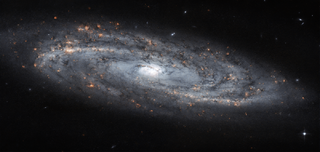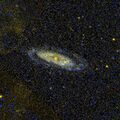Astronomy:NGC 4100
From HandWiki
Short description: Galaxy in the constellation Ursa Major
| NGC 4100 | |
|---|---|
 Hubble Space Telescope image of NGC 4100 | |
| Observation data (J2000 epoch) | |
| Constellation | Ursa Major |
| Right ascension | 12h 06m 08.602s[1] |
| Declination | +49° 34′ 56.32″[1] |
| Redshift | 0.003582[2] |
| Helio radial velocity | 1,072 ± 6 km/s[2] |
| Distance | 65.1 Mly (20.0 Mpc)[3] |
| Group or cluster | NGC 3992 group[4] |
| Apparent magnitude (B) | 11.7[2] |
| Characteristics | |
| Type | SAbc[2] |
| Mass | 33.3+10.7 −12.7×109[3] M☉ |
| Other designations | |
| NGC 4100, UGC 7095, MCG+08-22-068, PGC 38370[2] | |
NGC 4100 is a spiral galaxy in the northern constellation of Ursa Major. It was discovered by William Herschel on Mar 9, 1788.[5] This galaxy is a member of the NGC 3992 group in the Ursa Major Cluster.[4]
Gallery
NGC 4100 by GALEX
NGC 4100 by a 32-inch Schulman Telescope at the Mount Lemmon SkyCenter
References
- ↑ 1.0 1.1 Skrutskie, Michael F. et al. (1 February 2006). "The Two Micron All Sky Survey (2MASS)". The Astronomical Journal 131 (2): 1163–1183. doi:10.1086/498708. ISSN 0004-6256. Bibcode: 2006AJ....131.1163S.
- ↑ 2.0 2.1 2.2 2.3 2.4 "NGC 4100". SIMBAD. Centre de données astronomiques de Strasbourg. http://simbad.u-strasbg.fr/simbad/sim-basic?Ident=NGC+4100.
- ↑ 3.0 3.1 Lianou, S. et al. (November 2019). "Dust properties and star formation of approximately a thousand local galaxies". Astronomy & Astrophysics 631: 19. doi:10.1051/0004-6361/201834553. A38. Bibcode: 2019A&A...631A..38L.
- ↑ 4.0 4.1 Karachentsev, I. D. et al. (March 2013). "Anatomy of Ursa Majoris". Monthly Notices of the Royal Astronomical Society 429 (3): 2264–2273. doi:10.1093/mnras/sts494. Bibcode: 2013MNRAS.429.2264K.
- ↑ Seligman, Courtney. "New General Catalog Objects: NGC 4100 - 4149". https://cseligman.com/text/atlas/ngc41.htm#4144.
External links
 |




